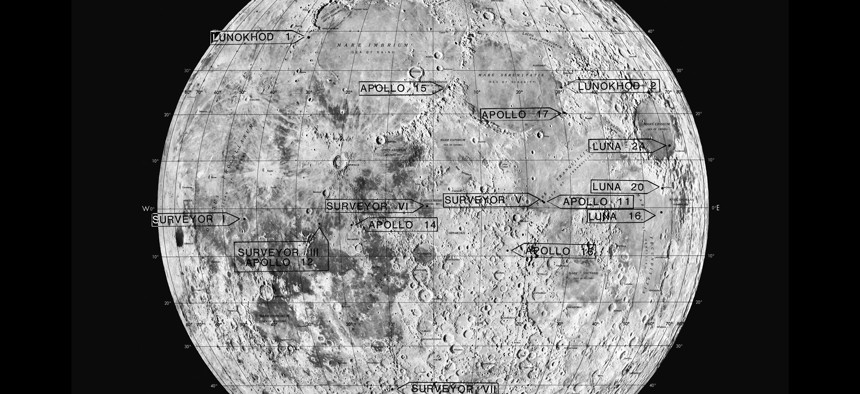
Lunar landing sites. NASA
Bringing GPS to the Moon Is the Next Frontier
The National Geospatial-Intelligence Agency is part of a government collaboration to bring precise navigation to the lunar surface.
ST. LOUIS—Could navigating around the Moon be as easy as loading your favorite GPS app? The Pentagon’s lead image-intelligence agency thinks so and is working to develop a lunar reference framework to guide future explorers around the Moon as safely and quickly as satellite-aided navigation does on Earth.
“Just as NGA’s predecessor agencies mapped the Moon ahead of the Apollo missions, today we're working with NASA, the U.S. Geological Survey, the U.S. Space Force, and U.S. Space Command to develop the lunar geodetic system that will guide future visitors around the moon surface as accurately and as safely as GPS does on Earth,” said Vice Adm. Frank Whitworth, director of the National Geospatial-Intelligence Agency, during his keynote speech at GEOINT Symposium 2023.
NGA is also “developing AI/ML technologies to model the Earth's gravitational field which can help us to fill in missing data where direct collection is difficult,” to bolster positioning, navigation and timing systems, Whitworth said.
The lunar framework is expected to be the first of many celestial body reference systems the agency will likely help shape in the future.
“Just about everyone who uses space realized we needed something that was an equivalent of WGS84 for our terrestrial kind of orientation. And it's a big deal. And we're not going to rush to failure on this one. We're actually really taking the right amount of time, both with ourselves and academic and other communities to ensure that we do it right,” Whitworth told reporters.
The information doesn’t yet exist, but once it does, the goal is to have the lunar reference, like the one used for GPS, to be public—and not just for military or government use, said James Griffith, who leads NGA’s Source Operations and Management Directorate, noting that NGA is the lead defense agency, but is not in charge of developing the reference.
“The moon as a planetary object operates very differently than the Earth. We know the types of data we need to collect. But we don't necessarily know how to collect it in that type of an environment because our tools aren't building that,” Griffith said.
But despite the amount of exploratory work left to do, there’s huge potential.
“However we land on this,” Griffith said. “This is truly...breaking ground in science.”




